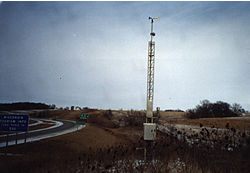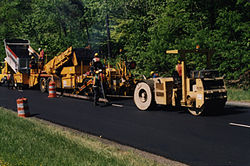U.S. Department of Transportation
Federal Highway Administration
1200 New Jersey Avenue, SE
Washington, DC 20590
202-366-4000
Focus
| Accelerating Infrastructure Innovations |
Publication Number: FHWA-RD-00-062
Date: October 2000
 |
| The bridge in Houston, Texas, was the first in the country to use high-performance concrete, one of the many technologies researched under SHRP, in all aspects of its construction. |
It's been described as one of the greatest success stories in the history of applied research. What began as a 5-year program in 1987 has changed the way State highway agencies design and build pavements, repair roads, clean up after winter storms, and build bridges. As the seven American Association of State Highway and Transportation Officials (AASHTO) Lead States teams for Strategic Highway Research Program (SHRP) implementation wrap up their work and the AASHTO Task Force on SHRP Implementation sunsets this fall, the success of SHRP and the efforts to implement its products and technologies are being realized across the country.
It is estimated, for example, that Superpave pavements will represent 41 percent of States' total hot-mix asphalt road projects this year, up from a mere 1 percent in 1996. Awareness that alkali-silica reactivity (ASR) in bridges is a problem that needs to be dealt with has risen from 13 States when the ASR Lead States team began its work to 40 States today. And because of dedicated activities ranging from developing and distributing videotapes, newsletters, and brochures to holding training courses, the Lead States teams and the Federal Highway Administration have guided States in implementing anti-icing techniques, building high-performance concrete pavements and bridges, and using pavement preservation strategies, among other technologies.Implementing SHRP products has proven to be beneficial economically. Boulder, Colorado, for example, found that using an anti-icing strategycost only half of what a conventional sanding and deicing strategy would have required. The Michigan Department of Transportation (DOT).
 |
 |
 |
| The success of SHRP can be seen in the implementation of such technologies as tests for alkali-silica reactivity, road weather information systems, and the Superpave system. |
Estimates that applying preventive maintenance treatments, such as chip sealing, to roads saved the State an estimated $700 million between 1992 and 1996. And the Virginia DOT estimates that using electrochemical chloride extraction technology added 12 to 15 years to the service life of two of its bridges.
Are these success stories the final chapter in SHRP implementation? While focused SHRP implementation activities by entities such as the Lead States teams are coming to a close, the various AASHTO subcommittees will continue to promote and advise States on the implementation of the SHRP technologies. Recognizing the success of the deployment of SHRP technology, AASHTO has formed a steering group for technology deployment to facilitate the implementation of high payoff, ready-to-use innovative technologies in the future (see sidebar). Focus, which started out chronicling the progress of SHRP research in 1987, will continue to report on these technology implementation efforts, as well as the real-life experiences of States using the SHRP products. But we're also expanding our coverage to include a broader range of infrastructure-related topics and developments. This expansion reflects the results of the 1999 reader survey, where the majority of respondents cited infrastructure as a key area to be emphasized. The expanded coverage is symbolized by our new look this month. We hope that you like it. And we hope that you continue to share both your SHRP implementation stories and your suggestions as to what you would like to see in future issues of Focus, so that we can continue to meet your needs. Focus, above all, remains dedicated to bringing innovations to infrastructure professionals worldwide.
| Members of AASHTO Steering Group for Technology Deployment
John Conrad, Washington State DOT (chair) Michael Behrens, Texas DOT Joe Denault, West Virginia DOT Randy Isawsaki, California DOT Doug Rose, Maryland DOT Warren Sick, Kansas DOT Freddie Simmons, Florida DOT Gary Taylor, Michigan DOT Paul Well, New York State DOT. |